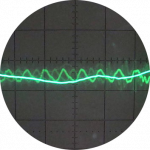Posted by: @cliffhangerCan't pm you I haven't enough posts.
Keep it out in the open! Others will want to have a look and possibly comment.
The heat loss report estimates the heat loss to be 7.42kW at -5.28°C (blimey, that's cold!), using what appears to be standard calculated methodology (areas U values air changes etc). There is a good chance this figure is too high, especially for an old building check the wall U values, there are also some links to published data on actual (measured) U values buried somewhere on the forum. Let's take 25% off: 5.5kW. The report mentions a Vaillant heat pump, but I thinks your is a Grant, either way, I think it is rated at 9kW. If these numbers (5.5 and 9) are correct, then there is a likely explanation for your heat pumps behaviour staring us in the face.
It is possible to get an empirical (measured) heat loss providing you have historical data of fuel usage (can be any fuel, but is easiest with gas). Basically, if your house is in steady state (steady room temp), then the energy being delivered to the house (energy in adjusted for efficiency) is the heat loss at that OAT. If you have such historical data, we can go through the method in more detail.
Midea 14kW (for now...) ASHP heating both building and DHW
@cliffhanger - thoughts on how to deal with your situation: I would still start with room stat set high and all TRVS etc open and then fine tune the weather compensation curve to as low as can be, but still sufficient to heat your home. It may take a lot of tweaking, all the more so if the heat pump is over-sized. It will struggle to lower output sufficiently (because it can only go down so far), and will end up cycling sooner than a less powerful model. Ignore what the curve numbers appear to be telling you - they are just numbers - and focus instead on the leaving water temp and room temp.
Midea 14kW (for now...) ASHP heating both building and DHW
Many thanks for the reply
Posted by: @cathoderayThe heat loss report estimates the heat loss to be 7.42kW at -5.28°C (blimey, that's cold!),
Yep. We're 250m up in the Cheviots in the Borders!
Posted by: @cathoderayis possible to get an empirical (measured) heat loss providing you have historical data of fuel usage (can be any fuel, but is easiest with gas).
I have none prior to central heating. We were using electric wall heaters(yeah you can guess what that cost!). We just had to get a grant.
Will try your suggestion asap
Cliff
Posted by: @cathoderayIgnore what the curve numbers appear to be telling you - they are just numbers - and focus instead on the leaving water temp and room temp.
So just to be clear here. Even when the OAT drops below freezing a low heating curve should still translate to a high LWT? Perhaps I'm not seeing something here.
Or is this a cumulative effect over a period?
Cliff
Posted by: @cliffhangerPosted by: @cathoderayIgnore what the curve numbers appear to be telling you - they are just numbers - and focus instead on the leaving water temp and room temp.
So just to be clear here. Even when the OAT drops below freezing a low heating curve should still translate to a high LWT? Perhaps I'm not seeing something here.
Or is this a cumulative effect over a period?
Cliff
The heating curve specifies a higher LWT at low OATs, and a lower LWT at higher OATs. Thats the whole point of the heating curve - it varies the LWT according to the OAT so that the energy emitted by the emitters (which increases with increasing LWT) closely matches the energy lost by the house (which increases with reducing OAT).
For most efficient operation you want the heating curve as low as possible consistent with just heating the house to the desired temperature. This point is best found by running the heat pump 24*7, opening all TRVs to maximum, setting any thermostats to maximum and turning off any room influence function of the heat pump controller itself - ie setting it up so that the only control is the weather compensation.
Many, including me, leave it like this, ie run the system purely on weather compensation with no influence at all from controls that measure the inside temperature. For many houses this works rather well, and better than any thermostat based system (there are good reasons for this buried in the whole branch of engineering called 'control theory').
4kW peak of solar PV since 2011; EV and a 1930s house which has been partially renovated to improve its efficiency. 7kW Vaillant heat pump.
Posted by: @cliffhangerYep. We're 250m up in the Cheviots in the Borders!
Ah, that explains it!
Posted by: @cliffhangerWe were using electric wall heaters(yeah you can guess what that cost!).
Been there, done that, it's horrible in every way. One major improvement I noticed going from mains electric (not storage) heaters to a heat pump was the house is much more comfortable, not just because it is warmer, obviously, but that pervasive clamminess and dampness of clothing and bedding disappears. It's partly a consequence of the heating being on low and slow most of the time. Back in the days when I had timed oil central heating, dampness was still a bit of a problem eg condensation forming overnight while the heating was off.
Posted by: @cliffhangerSo just to be clear here. Even when the OAT drops below freezing a low heating curve should still translate to a high LWT? Perhaps I'm not seeing something here.
Or is this a cumulative effect over a period?
Yes, it's all down to how a weather compensation curve works. Have a look at (or re-read if you have already seen it) this section of my ABC guide. The weather compensation curve sets up a direction connection between the OAT and the LWT. If a curve has, for example, settings of 45 @ -5 and 30 @ 15, then what that means is that when it is -5 outside, the set LWT will be 45 degrees (and the actual should be close), when it is 15 outside, the set LWT will be 30 degrees (and the actual will be very close), and in between -5 and 15 degrees outside the LWT is on a linear sliding scale between the two end points of 45 and 30 degrees, depending on the OAT. If the heat pump has to cycle, them the mean LWT should be close to the set LWT, though this can sometimes not be perfect eg during defrosts. The fine tuning of the weather compensation curve is the process of adjusting it up and down to find the point where for each point on the curve, the LWT ends up delivering just the right amount of heat to keep the home at a steady comfortable room temperature. It is a very simple but at the same time very elegant way of controlling a heating system.
To some extent there is a cumulative effect, because buildings have something called thermal mass, in that they act as heat sinks, or heat batteries. When the heating is on, you are 'charging' the fabric of your home with heat, which can then 'discharge' back into the home. Buildings with a large thermal mass take a while to warm up, but once warmed up, they also take a while to cool. They are a bit like a heavy cast iron frying pan, vs a light weight aluminium one. This thermal mass, as @jamespa wisely reminds us, is crucial to a technical understanding of how a home remains in thermal equilibrium (ie comfortable in plain English). Because of the 'low and slow' nature of heat pumps (as in they can't do 'hot and fast'), the general idea is you keep them ticking over most if not all of the time, at a level where the heat delivered to the home matches the heat being lost by the home to the outside, with ideally the only control being the weather compensation curve. I'm hazarding a guess here, but I suspect that given adequate system design and a properly set up weather compensation curve, 95% of homes won't need any other form of control. I say need, because there may by additional finer tuning controls like the Ecodan Auto-adapt mode, and Homely, that can tweak things still further, but they are not essential, in an adequate designed system, weather compensation can and arguably should provide all the necessary control.
Edit: I see @jamespa has posted while I was writing this, we're both basically saying the same thing!
Midea 14kW (for now...) ASHP heating both building and DHW
Posted by: @cathoderaya curve has, for example, settings of 45 @ -5 and 30 @ 15, then what that means is that when it is -5 outside, the set LWT will be 45 degrees (and the actual should be close), when it is 15 outside, the set LWT will be 30 degrees (and the actual will be very close), and in between -5 and 15 degrees outside the LWT is on a linear sliding scale between the two end points of 45 and 30 degrees, depending on the OAT. If the heat pump has to cycle, them the mean LWT should be close to the set LWT, though this can sometimes not be perfect eg during defrosts. The fine tuning of the weather compen
Thanks.
Yes I understand how the curve works. What's not clear is how can a low curve eg 0.3 that's right for the house temperature selected, but doesn't include the design temp, lead to 45 degree LWT at -5?
Am I making sense here? I dunno
In other words the design temp must be included at the low OAT end of the curve? I can't get this using the 'curve' and 'shift.' If I take the curve down I lose design temp.
Cliff
Personally I don't like these 'factor' curves eg what on earth does 0.3 mean? 0.3 of 1? ie range is 0-1? 0.3 of x, x being a numberless number meaningless to man.
Is there any way you can directly set the temperatures? Maybe other Grant Aerora 290 or just any Grant owners can advise? If not, can you see the numbers for the two ends of the curve, and then adjust what you can adjust to get them to move to where you want them, if that makes sense.
Posted by: @cliffhangerbut doesn't include the design temp, lead to 45 degree LWT at -5?
That doesn't matter. That 45 @ -5 comes from the heat loss calculations which we have already know may be a considerable over-estimate of your actual heat loss. If your actual heat loss at -5 is less than the estimated heat loss, then you can get away with a lower flow temp (and save some £££).
Midea 14kW (for now...) ASHP heating both building and DHW
Posted by: @cathoderayPersonally I don't like these 'factor' curves eg what on earth does 0.3 mean? 0.3 of 1? ie range is 0-1? 0.3 of x, x being a numberless number meaningless to man.
Is there any way you can directly set the temperatures? Maybe other Grant Aerora 290 or just any Grant owners can advise? If not, can you see the numbers for the two ends of the curve, and then adjust what you can adjust to get them to move to where you want them, if that makes sense.
Posted by: @cliffhangerbut doesn't include the design temp, lead to 45 degree LWT at -5?
That doesn't matter. That 45 @ -5 comes from the heat loss calculations which we have already know may be a considerable over-estimate of your actual heat loss. If your actual heat loss at -5 is less than the estimated heat loss, then you can get away with a lower flow temp (and save some £££).
I have a pump with the 'factor' curves and, once you understand them they are easy to operate, easier in fact than the '4 point' system. That said the Grant instructions (which I have just looked at) do seem to be a bit confusing relative to for example the Vaillant, Fujitsu or Ideal ones which use a similar system.
As @cathoderay says forget '45 @ -3'. This was based on the estimated heat loss which is based on lots of assumptions many of which will be incorrect. At this stage its history, all that matters is the house.
The procedure to follow is simple:
- Turn up any thermostats and TRVs to maximum
- Set the heat pump to operate 24x7
- Turn off any room influence/expanded/autoadapt mode
- Set any flow temperature 'offsets' to zero
This disables all external controls and means you are running purely on weather compensation. As a result your house will get too hot (if it doesnt then something is amiss, please repost).
Then
- Reduce the factor by the minimum amount (0.5 I think) each day, until your house is just at the right temperature. If it gets too cool you can bump it up a notch. If its way too hot to start then you can make bigger steps initially.
- If the rooms settle at vastly different temperatures, you may need to adjust one or more lockshield valves, please repost with details if that happens.
Job done, heat pump operating at its optimum. Thereafter make tiny tweaks rarely if you find that the house temperature is wrong consistently.
Hope that helps, it would definitely help if you posted some pictures of 'adjusting the heat curve in action'
Edit - I found a video here
You should watch it but Grant seem to have come up with the worst of all options (no surprise frankly!) and then described it in a muddle headed way. To first order I think you use it like this
The leftmost point on the curve is fixed.
You can adjust the outdoor temperature at which the flow temperature reaches its max (60C) by adjusting the 'curve' control.
You can adjust an intermediate point (ant thus the curvature) using the 'shift control
So I would start by setting an initial curve using a combination of the two which passes through 45@-3 (call this 42@0, rather easier to see)
Then shift it down bit by bit in accordance with the bulletted instructions above, probably using the 'shift' control or whichever one/combination keeps it approximately straight, or with a slight uplift from straight in the 3-10 region
Preferably post a video of you playing with both so we can see what it really does!
Hope that helps a bit more,
4kW peak of solar PV since 2011; EV and a 1930s house which has been partially renovated to improve its efficiency. 7kW Vaillant heat pump.
All one can say is many thanks for the help from all and more importantly patience!
Will now push on with pictures. I do have the manual incidentally. Yeah it's not altogether clear.
Regards
@cliffhanger suggest you reread my post above, I edited it after you looked at it. I found a video which helps a bit, but Grant do seem to have come up with something that isnt particularly self-explanatory (its nothing like Vaillant, Fujitsu, ideal who use preset curves)
4kW peak of solar PV since 2011; EV and a 1930s house which has been partially renovated to improve its efficiency. 7kW Vaillant heat pump.
Posted by: @jamespaYou should watch it but Grant seem to have come up with the worst of all options (no surprise frankly!) and then described it in a muddle headed way. To first order I think you use it like this
The leftmost point on the curve is fixed.
You can adjust the outdoor temperature at which the flow temperature reaches its max (60C) by adjusting the 'curve' control.
You can adjust an intermediate point (ant thus the curvature) using the 'shift control
So I would start by setting an initial curve using a combination of the two which passes through 45@-3 (call this 42@0, rather easier to see)
Then shift it down bit by bit in accordance with the bulletted instructions above, probably using the 'shift' control or whichever one/combination keeps it approximately straight, or with a slight uplift from straight in the 3-10 region
Thanks. I've seen the video several times at the beginning and frankly its useless. I expected more detail. If as cathode Ray says to largely ignore the design temp then it become easier to experiment.
I'll get back soon
Cliff
- 26 Forums
- 2,342 Topics
- 53 K Posts
- 222 Online
- 6,000 Members
Join Us!
Worth Watching
Latest Posts
-
RE: Poll for Time of Use, tariffs, technology
Watch EON. I am currently with them but the renewal te...
By JamesPa , 13 minutes ago
-
RE: 10kw heat pump run in 24*7 data?
The curve really depends on the emitters in relation to...
By JamesPa , 17 minutes ago
-
RE: Has Anyone Else Noticed a Decline in Tradesmanship?
Sadly that is true. There are various reasons of cours...
By JamesPa , 22 minutes ago
-

RE: Here is my heat pump installation with questionable COP in Italy
@materox345 It would seem that some installers regard t...
By Toodles , 43 minutes ago
-

I have just had a new solar array and batteries install...
By TechnoGeek , 4 hours ago
-

RE: Configuration issues with 10kW Midea R32 heat pump
You need to set the one shown in the photo you posted t...
By cathodeRay , 5 hours ago
-

RE: What a Bad Heat Pump Installation Looks Like
@editor The trick to an inside unit installation is to ...
By MikeFl , 13 hours ago
-
RE: Different dT on each radiator?
The way heating systems are designed will result in rou...
By JamesPa , 16 hours ago
-

RE: Setback savings - fact or fiction?
PS by visually merging the two tables as above, I ended...
By cathodeRay , 1 day ago
-

RE: Homely for Daikin Altherma 3 - Petersfield Area
@russ If you would care to pose your questions on one o...
By Toodles , 1 day ago
-

RE: A Smarter Smart Controller from Homely?
@papahuhu I have a feeling that my Homely smart control...
By Toodles , 1 day ago
-

RE: The good, the bad and the not that great – my heat pump installation
@cathoderay the guy I spoke to on the phone seemed very...
By Burtis , 2 days ago
-
RE: British Gas vs Octopus Energy vs Heat Geek vs EDF vs Aira vs OVO vs EON.Next vs Boxt
I get the impression that that comment "they don't comm...
By JamesPa , 2 days ago
-

@majordennisbloodnok Just in case there are variations ...
By Toodles , 2 days ago
-

RE: Latest NIBE model has known defect and no solution
@kings I’m glad I could help. NIBE are taking this very...
By Mars , 2 days ago
-
RE: Octopus Cosy Heat Pump Owners & Discussion Thread
@jamespa yes, I'm under no illusions but in some respec...
By AndrewJ , 2 days ago
-
RE: Electricity price predictions
It seems the end of cfd payments is in sight, even if a...
By Batpred , 2 days ago
-
-
@pie_eater Yes, I installed Homely to a Daikin heat pum...
By gery , 3 days ago




